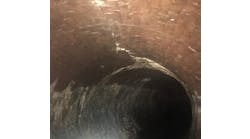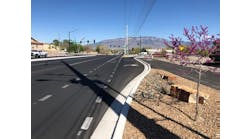These days, state highway departments do more than just pave roads and build bridges. Their responsibilities include environmental stewardship, and DOTs are sometimes the first line of defense for eliminating surface water pollution.
The California Department of Transportation (Caltrans) builds and maintains some of the world's busiest highways, including the extensive Southern California freeway system. The vast number of roads in and around Los Angeles collect and channel enormous amounts of water, water that eventually makes its way to local streams, rivers and, in this case, the Pacific Ocean.
I-210 is one of these roads. It is a relatively new eight-lane freeway skirting the northern boundary of the Greater L.A. Basin. The recently opened six-mile section of the freeway bisects numerous densely populated suburban communities so traffic is usually heavy, well in excess of 100,000 vehicles per day.
With the beautiful San Bernardino Mountains on the horizon, the highway was built primarily below grade so the view would not be obstructed. Essentially, it is a concrete trench nearly six miles in length. The highway is drained by a reinforced concrete box culvert measuring 3 x 1.5 meters. In L.A.'s arid climate, rainfall events are infrequent but often intense, and the runoff is usually packed with all kinds of pollutants and trash.
"The Los Angeles Regional Water Quality Control Board has started to adopt specific total maximum daily loads (TMDLs) for a variety of water courses in the L.A. area," explained Doug Failing, who as Caltrans' District 7 director is responsible for the highways in Los Angeles and Ventura counties. "This includes a 'zero trash' policy. At present, this policy doesn't apply to the watershed where I-210 is located, but it probably will soon. This type of environmental policy is the way of the future because it's a good thing to do; it's good for our state and our region."
According to Failing, the runoff from I-210 contains the usual debris: cups, cans, plastic and paper. And like most highways, it also has a toxic mix of metals such as beryllium from tires, aluminum from auto chassis parts, iron from engines and copper from brake linings. These metals, along with oil and other materials, settle into the sediment along the highway and then wash into the storm drain during rain events. Much of this trash and pollution eventually ends up in the Pacific where it becomes a real environmental concern.
"Here in L.A. we want to keep our coasts clean," said Failing. "It's important to our residents and our economy."
The screens clean
Caltrans looked at several options for cleaning the highway's storm water runoff. Installing screens or baskets at storm water drains was quickly ruled out. Such devices require cleaning after almost every rain event and the drains are located within a few feet of high-speed traffic. The high level of maintenance and the safety factor for workers made this option unacceptable.
Clearly, an end-of-line cleaning process was preferred, but there were other factors affecting the decision. Volumetric-type devices that catch and hold large amounts of water for a long time were considered, but in this densely populated area it would have required Caltrans to displace several homes and it would have cost millions of dollars.
With these limitations, Caltrans engineers began looking at flow-based treatment devices. These devices accept a flow of water, put it through a treatment process, then release the water to continue its journey downstream.
"There are very few flow-based treatment devices available to us," said Failing. "We had been experimenting with CDS (continuous deflection separation) units for some time. I like the screening device. It not only captures trash, you get a high level of sediment removal as well, and that was very important to us."
One of the biggest benefits of the CDS technology in this application was that Caltrans could fit a CDS unit into a small patch of land that could be easily and affordably obtained.
"What we did was find pockets of land away from the highway where we could put in CDS units," said Failing. "We're very conscious of maintenance activities where we have freeway flow, for two reasons: one, when people see maintenance workers they tend to slow down, look and not pay attention to other cars. Two, exposing our workers to traffic is dangerous. In this case the CDS unit is about a quarter-mile from the freeway. It's very safe."
There are actually five CDS units incorporated into the new I-210 freeway system, one of which is the largest CDS unit ever installed in the U.S. The pit excavated for the largest unit was 40 ft wide, 40 ft long and 38 ft deep. The cylindrical screen assembly on the unit is 15 ft in diam. by 15 ft tall. The unit is designed to filter a "first flush" runoff event of 175 cfs (78,400 gpm).
"One of the advantages of this technology is that it is scalable," said Mark Cuneo, P.E., of CDS Technologies, Long Beach, Calif. "We can build them as large or as small as needed. The objective is to be the most economical in terms of construction and long-term maintenance costs."
The CDS system is entirely self-operating, relying on water hydraulics, gravity and a non-blocking screen. Raw storm water enters the CDS diversion chamber where a weir guides the flow into the unit's separation chamber. A vortex is formed that spins floatables and suspended solids around the screen cylinder. The screen deflects the pollutants to the center of the separation chamber. The trash and suspended solids gently settle into a sump where they remain until they are removed. The water passes through the screen, out of the separation chamber and into the diversion chamber, then re-enters the storm water flow headed downstream. Caltrans expects to have to clean the sump of this particular unit only twice a year.
While most CDS units are precast, the size of the biggest unit on the I-210 project required that it be cast-in-place. However, the project presented few difficulties for the contractor.
"The construction wasn't too difficult; it's basically a large concrete cylinder cast in place on a concrete foundation," explained contractor Don Reiter of Yeager Skanska Inc., Riverside, Calif. "The CDS people were very helpful in answering questions for us. It was a very interesting project simply because of the size."
Trust worthy
According to Caltrans' Failing, the real issue for most DOTs is performance. This is what really separates the CDS technology from other end-of-line storm water treatment devices. The CDS unit removes 100% of the floatables and has been shown to remove 80% of total suspended solids from storm water runoff. Plus, it has no moving parts and requires minimal maintenance.
"This unit performs very well," said Failing. "It saves us in maintenance costs, it's safe for the workers and it cost less than a fourth of what it would have cost us to build a volumetric-based treatment device.
"We have a responsibility as stewards of the public trust to spend the public's money wisely and minimize the impact on traffic and the environment," Failing added. "These devices help us work within the greater public trust."


